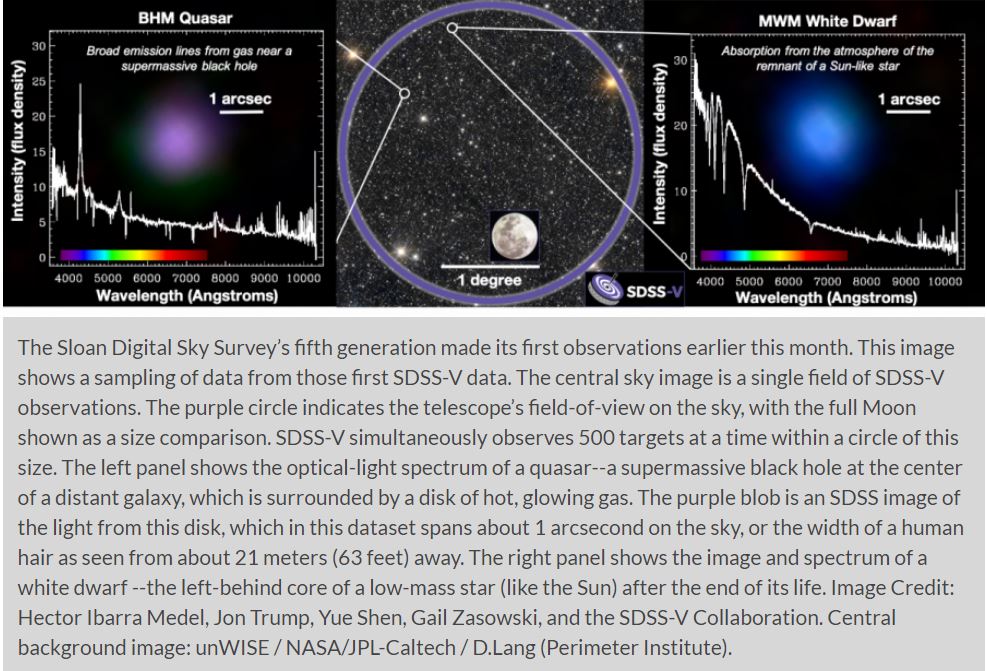
The fifth generation of the Sloan Digital Sky Survey is collecting data about our universe for Vanderbilt University astronomers and other project members to use to explore the formation of distant galaxies and supermassive black holes, and to map the Milky Way.
The SDSS-V will make full use of existing satellites, including NASA’s Transiting Exoplanet Survey Satellite mission, to lead to new discoveries. Keivan Stassun, Stevenson Professor of Physics and Astronomy, is co-investigator of NASA TESS, which enabled the discovery of a newly formed exoplanet in June 2020. That discovery boosted the potential for a joint effort with SDSS data.
“SDSS-V will magnify the exoplanet discoveries from TESS, both retrospectively and prospectively,” Stassun said. “Retrospectively in the sense that SDSS-V data will provide a rich characterization of the chemical makeup of the exoplanet systems that TESS has already discovered; prospectively in the sense that SDSS-V will provide the same rich characterization for millions of stars whose planets TESS has yet to find. Even more prospectively, the combination of SDSS-V and TESS data will enable us to confidently identify the most promising planets whose atmospheres we will study for habitability with the upcoming Twinkle mission.”
Set to launch in late 2023, Twinkle will deliver unprecedented satellite telescope data about the elemental composition of exoplanet atmospheres. Vanderbilt and The Ohio State University have become founding members of the mission.
Further, the latest SDSS-V data will inform the research of Assistant Professor of Astronomy and Physics Jessie Runnoe, whose work primarily focuses on quasars—supermassive black holes that feed on disks of gas and dust in the centers of distant galaxies.
Quasars give off a tremendous amount of light energy, and Runnoe studies the environments that make them or cause them to change over time. The latest release from SDSS-V will enable her to digest huge quantities of data into new observations and conclusions. The new data will make it much easier to see how, when and why quasars are changing, Runnoe explains.
“Quasars are so far away that capturing an image makes it look like it’s a star,” Runnoe said. “The real action is looking at how the energy, or light, output of quasars appears when it’s spread out over different wavelengths. Having consistent data over time from SDSS-V will help us create a benchmark to understand how quasars really behave.”
Operating out of Apache Point Observatory in New Mexico and Las Campanas Observatory in Chile, SDSS has been providing publicly available data since 1998. This survey has given scientists the tools to create the most detailed map yet of the known universe, discover earth-like planets and observe other celestial bodies.
“The quantity of information provided by SDSS-V is astronomical in both senses of the word. We are looking forward to turning this data into a new understanding of our place in the universe with Prof. Runnoe,” said Andreas Berlind, co-director of Vanderbilt’s Data Science Institute and associate professor of physics and astronomy.
In a release, program director at the Sloan Foundation Evan Michelson said, “SDSS-V will continue to transform astronomy by building on a 20-year legacy of path-breaking science, shedding light on the most fundamental questions about the origins and nature of the universe. It demonstrates all the hallmark characteristics that have made SDSS so successful in the past: open sharing of data, inclusion of diverse scientists, and collaboration across numerous institutions.” The release also highlights the leadership role of Vanderbilt Research Assistant Professor Jon Bird in the overall design and implementation of the SDSS-V mission.
“Supermassive black holes eat like the Cookie Monster—more comes out than comes in,” said Runnoe, also a faculty affiliate at the Data Science Institute. “My interest is in understanding environments that feed these black holes. I am looking forward to maximizing the data we have, it’s a great challenge.”
Runnoe believes this publicly available data will encourage critical thinking and allow researchers to better communicate their findings to the general public. “We’re getting into an era where we’re making movies out of the sky, not just pictures,” said Runnoe. “It’s exciting to unravel mysteries we’ve been stuck on.” https://news.vanderbilt.edu/2021/01/04/digital-sky-survey-maps-the-entire-sky-providing-new-data-to-vanderbilt-astronomers/







Recent Comments